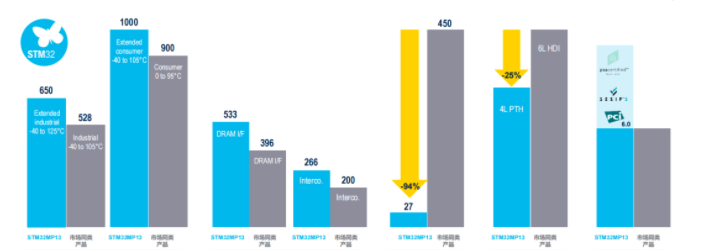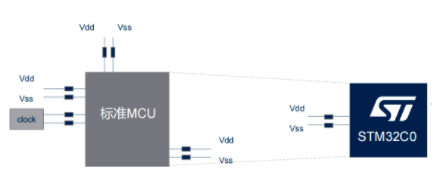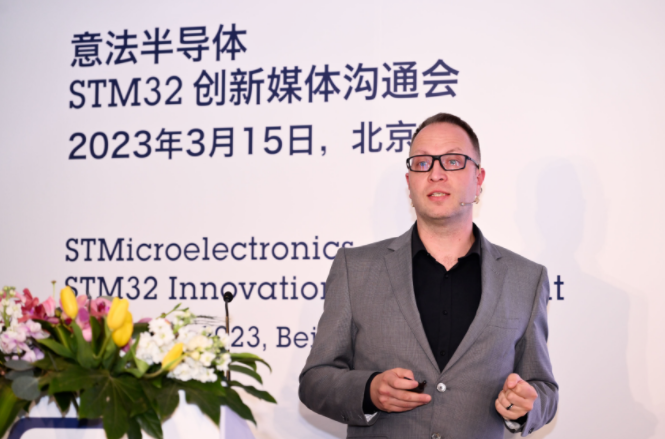Since the release of the first STM32 in 2007, ST has a total of 20 sub-lines in five major product series, including wireless, ultra-low power consumption, mainstream, high-performance and microprocessor MPU series. STM32 global shipments have exceeded 11 billion pieces. It is precisely because of the continuous innovation of new STM32 products and the improvement of the product matrix that ST’s MCU market share has increased year by year. In the general microcontroller market, ST has jumped from the third position in 2017 to the first in 2021. Location. These growths and rankings come from own organic growth without any big acquisitions and mergers.
With the advent of the digital age, ST has seen a broader MCU market demand, and digitalization will bring about a greater growth of up to four times the 32-bit MCU. Especially in the field of industrial control, which accounts for more than half of the general MCU market, and STM32 has regarded the field of industrial control as an important place since its launch.
Against this background, ST has recently launched a series of new MCU product updates, which cover the five major series of the STM32 family, and are the crystallization of ST’s continuous innovation in the past 2 years. From these new products of ST, we may be able to draw some development trends of MCU. Next, let’s analyze the characteristics of these new products of ST one by one.
The rival of 8-bit MCU – STM32C0
Imagine, if you can enjoy a 32-bit MCU at the cost of an 8-bit MCU, would you upgrade?
It has to be said that 8-bit MCUs still occupy a large position in the market. According to Cao Jindong, director of STMicroelectronics MDG China, 8-bit MCUs account for about 25% of the entire market. They are mainly used in smart homes, smart devices, and smart hardware (computer peripherals and accessories), which is a very broad industry, especially in China.
Cao Jindong, Director of STMicroelectronics MDG China
In the past, ST had a simple 8-bit MCU, but as more and more customers began to upgrade their industries and applications, they had needs for display screens, sensor data acquisition, and human-computer interaction. Therefore, ST has launched an MCU product such as STM32C0. STM32C0 is the most economical 32-bit MCU launched by ST. It is based on the Arm® Cortex® -M0+ core and is mainly for cost-sensitive users. Specifically, it is mainly for consumer electronics such as small appliances, toys, and simple smart home control.
STM32C0 has three major characteristics: economical, reliable, and continuous. Specifically:
First of all, ST continues to reduce the cost of materials through design and factory optimization, including smaller and compact package design, minimum peripheral devices, etc., making STM32C0 have an attractive price. At present, some customers have started to use STM32C0 to make new designs, or switch from STM8 to STM32, which also proves that the price of STM32C0 has been recognized by the market.
Although there are some optimizations in design and manufacturing, there is no compromise on reliability and quality. ST has its own DNA or design methods to ensure the reliability of the design;
STM32C0 provides a variety of packaging methods, including traditional TSSOP, relatively medium UFQFPN, oriented to sensor nodes, and also provides a more compact mobile phone-oriented application WLCSP. Moreover, the packaging area of STM32C0 is the same as that of STM32G0, and the pin positions are the same. They both use 90nm process and share IP and technology platform. So whether it is STM8 or STM32F0, there is not much change and difficulty in the transition to STM32C0.
In addition, STM32C0 also has excellent dynamic power consumption, with normal operation mode, stop mode, standby mode and Shutdown mode. For example, Shutdown mode can only be woken up by simple I/O ports and negative circuits, and its power consumption is only 20nA.
Cao Jindong shared a practical case: “In the past, when a customer made smart curtains, the customer needed to use an STM8S for motor control and an STM8 for the remote controller. Today, only one STM32C0 is used to replace STM8S and STM8. Help customers reduce Supply chain complexity, while improving the overall control performance.” STM32C0 realizes that “the next 8-bit MCU is actually a 32-bit MCU”, which refers to cost performance and cost.
While this product is relatively simple, providing an evaluation board is anything but simple. ST will still provide Nucleo boards and micro evaluation boards based on STM32C0, and at the same time provide a minimum system board based on STM32C0, which customers can insert into the prototype for early prototype verification or functional verification. Therefore, as a minimum system, in the customer’s own Before the board comes out, this board can be used for system verification and prototype development, which can help customers do fast product verification and development cycles. Cao Jindong said that we hope that the price of this board will be affordable to all users.
High-performance MCU for security challenges – STM32H5
STM32H5 is a member of ST high-performance MCU series, based on Cortex-M33, using 40nm process. It also has three main features, one is fast, STM32H5 is the fastest Cortex-M33 product in STM32, the operating frequency is up to 250 MHz; the second is security scalable, built-in Secure Manager security manager, which simplifies the customer development process and supports security Seamless cloud/server connection, enabling a variety of customer application scenarios, from basic security building blocks to certified security services maintained by STMicroelectronics; the third is to achieve a balance between optimized cost/performance, STM32H5 is based on ST Optimized 40nm process, while providing a wealth of storage, peripherals and packaging options.
“Due to the use of the Cortex-M33 core, the STM32H5 itself has a 25% improvement in the core compared to the Cortex-M4 (180MHz). Not only the core improvement, but the STM32H5 also has an accelerator improvement: STM32H5′s new ART Accelerator™ for internal It is also effective for reading instructions and data; two math accelerators FMAC and Cordic have been added.” He Difan, senior manager of technical marketing of STMicroelectronics MDG China General Microcontroller Division, emphasized.
He Difan, Senior Manager of Technology Marketing, General Microcontroller Division, STMicroelectronics MDG China
For applications that require power consumption, such as consumer and Internet of Things, STM32H5 can add options for switching mode power supplies to customers, including shutdown, standby, and VBAT modes. Even in the running process of 250MHz, the power consumption of 66μA/MHz can be achieved.
Ultra-low power consumption and high security wireless MCU—STM32WBA
In the era of the Internet of Things, information security is getting more and more attention, so in 2019, ST launched the wireless series STM32WB.
This time, ST has launched the latest STM32WBA series products. What new features does it have?
STM32WBA product block diagram
In terms of wireless communication, STM32WBA supports BLE5.3, supports long-distance communication, 2Mbps transmission rate, and supports extended broadcasting. The STM32WBA is the first device of its class to achieve an output power of +10 dBm. This means that when the STM32WBA is connected to the device, even if the connection signal is unstable, it can be connected to the device through a stronger wireless link.
From a performance point of view, the STM32WBA series adopts the Cortex®-M33 single-core architecture, the main frequency is up to 100MHz, the CoreMark score is 407, and it supports fast wake-up function. Based on such a single-core architecture and main frequency, STM32WBA has the computing power to run more complex algorithms such as fingerprint recognition or anomaly detection.
In terms of energy efficiency, because it is based on the STM32U5 ultra-low power platform, it inherits the characteristics of digital and analog peripherals, has excellent performance per power ratio, and can support low-power STOP0, STOP1 and standby modes.
In terms of security, STM32WBA itself provides secure boot, secure update, and secure firmware installation functions from the TrustZone M33 core. In addition, it also enhances security considerations from the chip’s own IP, adding memory protection, Encryption function, platform protection, and code isolation design allow engineers to avoid the interference of wireless protocols for some sensitive applications, and even further protect some user data or cloud verification data. STM32WBA is also the first wireless product to pass the SESIP Level3 certification, and at the same time pass the PSA certification.
In terms of integration, Flash can support up to 1MB flash memory and 128KB SRAM.
Finally, there is the ecosystem. STM32WBA is integrated in the complete ecosystem of STM32, which can help developers save development cycles and get products to market quickly and effectively.
Embedded applications bloom two flowers, the other is MPU
There are two main directions in the field of embedded applications, one is MCU, and the other is MPU. Compared with MCU, MPU can be configured with more and more extensive software. Users will use the Linux system for development in high-end applications, or in scenarios where computing power is particularly emphasized and the application system is particularly complex. Therefore, 3 years ago, ST released the MPU series based on Cortex®-A7 dual-core and integrated Cortex®-M4-STM32MP15x product line.
The new product launched by ST this time is STM32MP13. This is an industrial-grade general-purpose MPU product with many features: cost-effective, easy to use, safe, and low power consumption. The STM32MP13 is the most affordable STM32 MPU to date.

The STM32MP13 features a single Arm® Cortex®-A7 core clocked at up to 1GHz. Integrating innovative energy-saving features, equipped with dual Gigabit Ethernet ports and comprehensive security functions, through encryption algorithm accelerator, side channel protection, anti-tampering, secure storage, with Arm TrustZone® technology and trusted firmware (TF-A and OP- TEE) secure processing environment to ensure high security of IoT devices.
Benchmark similar products in the market. In terms of CPU performance of STM32MP13, the main frequency of Corte-A7 is as high as 1GHz, which is the highest among similar products in the industry. In addition, it supports the widest junction temperature range -40 ℃ -+125 ℃; in terms of system performance, STM32MP13 supports 533MHz DRAM, which is also the highest among similar products in the industry, and has optimized internal interconnection; in terms of power consumption, Standby’s The power consumption can be as low as 27μw. Compared with 450μW of similar products in the industry, the standby power consumption of STM32MP13 is one-fifth of it; PCB design can support lower cost, STM32MP13 supports PCB design of BGA p0.5mm; STM32MP13 Built-in powerful security functions, in addition, security functions have passed certifications for different industries, including the strict SESIP level 3 certification, PCI PTS 6.0 certification for the mobile payment industry, and ARM’s PSA Certified certification, which is unmatched by similar products in the industry Yes, this will greatly speed up the time for the user’s final product to be certified and launched.
Significantly expand capacity while maintaining flexibility and resilience
While constantly launching new products, ST also attaches great importance to the flexibility and toughness of the STM32 supply chain. In this regard, ST is deploying a long-term plan.
In 2022, ST will invest USD 3.5 billion to expand production capacity. In 2023, ST will invest more than US$4 billion in capacity expansion, a large part of which will be used to support the capacity expansion of STM32 at 90nm and 40nm nodes. In addition to using ST’s internal production capacity, it is also actively cooperating with multiple global foundries. These cooperations not only support this year and next year, ST plans to allow them to support customer needs for the next four to six years or even longer. This means that from now to 2025, ST’s wafer production capacity will increase significantly, roughly doubling. ST will expand global wafer testing and post-process packaging and testing capacity accordingly in accordance with the plan.
Regarding the tenacity of the new product supply chain, ST’s proposition is that we recommend that there be a sufficient supply chain or a complete supply chain in one place, but the production supply chain will also be deployed in major regions of the world. That is, the capacity and process of internal and external capacities support the production of most products in the STM32 series at the same time. In short, ST will ensure that the products are produced in regions A and B, as well as in factories A and B at the same time, and at the same time ensure that the performance parameters of the products produced are completely consistent.
This combination of internal and external fabs makes ST’s supply chain very flexible, according to STMicroelectronics Microcontroller and Digital IC Product Department MDG Asia Pacific, Internet of Things/Artificial Intelligence Innovation Center and Digital Marketing Vice President Julian explained : “If the market demand increases, we will use both internal and external wafer foundries. If the demand drops slightly or remains flat, we may only use internal factories. This year in STM32WBA, STM32MP1, STM32H5 and STM32C0, but ST There are also MCU, Power, MEMS, sensors, and analog devices. The demand trend of these products is on the rise. Maybe a product may not have the same strong demand in the same period, but we have a mixed combination that can ensure that our factories can operate at full capacity.”
From these new product releases of ST, we can roughly draw some MCU development trends. As far as the MCU product itself is concerned:
First of all, low cost and low power consumption need to be pursued continuously;
Secondly, new functions are added one after another. Accelerators, security, and wireless connections have gradually become the “little tail” of MCUs, namely MCU+AI, MCU+security, MCU+wireless, etc. These are becoming important strategic directions for ST MCUs. At the same time, ST It will also rely on STM32 MPU to win new high-value application opportunities;
The evolution of MCU in terms of technology is relatively stable, and MCU has high requirements for Flash. For the current stable and reliable embedded memory, or non-volatile memory, the most mature and latest technology is 40 nanometers;
Finally, the transition from 8-bit to 32-bit MCU is inevitable. ST said that its STM8A released in 2021 will be discontinued in the next 10 years. ST has informed customers of this news, and STM8 will no longer promote new designs. , 8-bit production capacity will not be expanded.
Post time: Apr-13-2023





